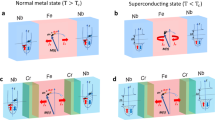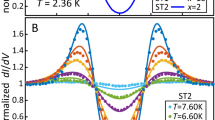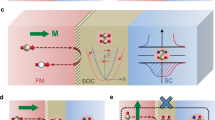Abstract
Superconducting spintronics has emerged in the past decade as a promising new field that seeks to open a new dimension for nanoelectronics by utilizing the internal spin structure of the superconducting Cooper pair as a new degree of freedom1,2. Its basic building blocks are spin-triplet Cooper pairs with equally aligned spins, which are promoted by proximity of a conventional superconductor to a ferromagnetic material with inhomogeneous macroscopic magnetization3. Using low-energy muon spin-rotation experiments we find an unanticipated effect, in contradiction with the existing theoretical models of superconductivity and ferromagnetism: the appearance of a magnetization in a thin layer of a non-magnetic metal (gold), separated from a ferromagnetic double layer by a 50-nm-thick superconducting layer of Nb. The effect can be controlled either by temperature or by using a magnetic field to control the state of the remote ferromagnetic elements, and may act as a basic building block for a new generation of quantum interference devices based on the spin of a Cooper pair.
This is a preview of subscription content, access via your institution
Access options
Subscribe to this journal
Receive 12 print issues and online access
$259.00 per year
only $21.58 per issue
Buy this article
- Purchase on SpringerLink
- Instant access to full article PDF
Prices may be subject to local taxes which are calculated during checkout




Similar content being viewed by others
References
Linder, J. & Robinson, J. W. A. Superconducting spintronics. Nature Phys. 11, 307–315 (2015).
Eschrig, M. Spin-polarized supercurrents for spintronics. Phys. Today 64(1), 43–49 (2011).
Buzdin, A. I. Proximity effects in superconductor–ferromagnet heterostructures. Rev. Mod. Phys. 77, 935–976 (2005).
Jiang, J. S., Davidović, D., Reich, D. H. & Chien, C. L. Oscillatory superconducting transition temperature in Nb/Gd multilayers. Phys. Rev. Lett. 74, 314–317 (1995).
Ryazanov, V. V. et al. Coupling of two superconductors through a ferromagnet: Evidence for a π junction. Phys. Rev. Lett. 86, 2427–2430 (2001).
Kontos, T. et al. Josephson junction through a thin ferromagnetic layer: Negative coupling. Phys. Rev. Lett. 89, 137007 (2002).
Demler, E. A., Arnold, G. B. & Beasley, M. R. Superconducting proximity effects in magnetic metals. Phys. Rev. B 55, 15174–15182 (1997).
Bergeret, F. S., Volkov, A. F. & Efetov, K. B. Long-range proximity effects in superconductor–ferromagnet structures. Phys. Rev. Lett. 86, 4096–4099 (2001).
Kadigrobov, A., Shekhter, R. I. & Jonson, M. Quantum spin fluctuations as a source of long-range proximity effects in diffusive ferromagnet-superconductor structures. Europhys. Lett. 54, 394–400 (2001).
Eschrig, M., Kopu, J., Cuevas, J. C. & Schön, G. Theory of half-metal/superconductor heterostructures. Phys. Rev. Lett. 90, 137003 (2003).
Keizer, R. S. et al. A spin triplet supercurrent through the half-metallic ferromagnet CrO2 . Nature 439, 825–827 (2006).
Robinson, J. W. A., Witt, J. D. S. & Blamire, M. G. Controlled injection of spin-triplet supercurrents into a strong ferromagnet. Science 329, 59–61 (2010).
Khaire, T. S., Khasawneh, M. A., Pratt, W. P. Jr & Birge, N. O. Observation of spin-triplet superconductivity in Co-based Josephson junctions. Phys. Rev. Lett. 104, 137002 (2010).
Bergeret, F. S., Volkov, A. F. & Efetov, K. B. Induced ferromagnetism due to superconductivity in superconductor–ferromagnet structures. Phys. Rev. B 69, 174504 (2004).
Löfwander, T., Champel, T., Durst, J. & Eschrig, M. Interplay of magnetic and superconducting proximity effects in ferromagnet–superconductor–ferromagnet trilayers. Phys. Rev. Lett. 95, 187003 (2005).
Pugach, N. G. & Buzdin, A. I. Magnetic moment manipulation by triplet Josephson current. Appl. Phys. Lett. 101, 242602 (2012).
Salikhov, R. I. et al. Experimental observation of the spin screening effect in superconductor/ferromagnet thin film heterostructures. Phys. Rev. Lett. 102, 087003 (2009).
Xia, J., Shelukhin, V., Karpovski, M., Kapitulnik, A. & Palevski, A. Inverse proximity effect in superconductor–ferromagnet bilayer structures. Phys. Rev. Lett. 102, 087004 (2009).
Khaydukov, Y. N. et al. On the feasibility to study inverse proximity effect in a single S/F bilayer by polarized neutron reflectometry. JETP Lett. 98, 116–120 (2013).
Flokstra, M. G. et al. Measurement of the spatial extent of inverse proximity in a Py/Nb/Py superconducting trilayer using low-energy muon-spin rotation. Phys. Rev. B 89, 054510 (2014).
Fominov, Y. V. et al. Superconducting triplet spin valve. JETP Lett. 91, 308–313 (2010).
Leksin, P. V. et al. Evidence for triplet superconductivity in a superconductor–ferromagnet spin valve. Phys. Rev. Lett. 109, 057005 (2012).
Zhu, L. Y. et al. Unanticipated proximity behavior in ferromagnet–superconductor heterostructures with controlled magnetic noncollinearity. Phys. Rev. Lett. 110, 177001 (2013).
Flokstra, M. G. et al. Controlled suppression of superconductivity by the generation of polarized Cooper pairs in spin-valve structures. Phys. Rev. B 91, 060501(R) (2015).
Bakule, P. & Morenzoni, E. Generation and applications of slow polarized muons. Contemp. Phys. 45, 203–225 (2004).
Noh, T., Houzet, M., Meyer, J. S. & Chandrasekhar, V. Nonlocal spin correlations mediated by a superconductor. Phys. Rev. B 87, 220502(R) (2013).
Sengupta, K. & Yakovenko, V. M. Spontaneous spin accumulation in singlet-triplet Josephson junctions. Phys. Rev. Lett. 101, 187003 (2008).
Sears, M. R. & Saslow, W. M. Spin accumulation at ferromagnet/nonmagnetic material interfaces. Phys. Rev. B 85, 014404 (2012).
Manchon, A., Ryzhanova, N., Vedyayev, A., Chschiev, M. & Dieny, B. Description of current-driven torques in magnetic tunnel junctions. J. Phys. Condens. Matter 20, 145208 (2008).
Grein, R., Eschrig, M., Metalidis, G. & Schön, G. Spin-dependent Cooper pair phase and pure spin supercurrents in strongly polarized ferromagnets. Phys. Rev. Lett. 102, 227005 (2009).
Alidoust, M., Linder, J., Rashedi, G., Yokoyama, T. & Sudbø, A. Spin-polarized Josephson current in superconductor/ferromagnet/superconductor junctions with inhomogeneous magnetization. Phys. Rev. B 81, 014512 (2010).
Alidoust, M. & Halterman, K. Spontaneous edge accumulation of spin currents in finite-size two-dimensional diffusive spin-orbit coupled SFS heterostructures. New J. Phys. 17, 033001 (2015).
Prokscha, T. et al. The new μE4 beam at PSI: A hybrid-type large acceptance channel for the generation of a high intensity surface-muon beam. Nucl. Instrum. Methods A 595, 317–331 (2008).
Acknowledgements
We acknowledge the support of the EPSRC through Grants No. EP/J01060X, No. EP/J010626/1, No. EP/J010650/1, No. EP/J010634/1 and No. EP/J010618/1, support of a studentship supported by JEOL Europe and the ISIS Neutron and Muon Source, and the support of the RFBR via awards No. 13-02-01452-a, No. 15-52-10045-Ko-a and No. 14-02-90018 Bel-a. All muon experiments were undertaken courtesy of the Paul Scherrer Institute. We thank J. M. Porro for assistance in acquiring the AFM images.
Author information
Authors and Affiliations
Contributions
J.K. and G.B. developed the samples; M.G.F., S.L.L., N.S., J.F.K.C., H.L. and T.P. performed the muon measurements, in which H.L., A.S. and T.P. provided the beamline support; M.G.F., S.L.L., N.S., J.F.K.C., P.J.C., S.J.B., C.J.K. and S.L. performed various support and characterization measurements; A.I., N.P. and M.E. provided theoretical interpretation of the data and helped writing the paper; G.B. and M.E. helped designing the study; M.G.F. and S.L.L. designed the study, analysed data and wrote the paper. All authors discussed the results and commented on the manuscript.
Corresponding author
Ethics declarations
Competing interests
The authors declare no competing financial interests.
Supplementary information
Supplementary information
Supplementary information (PDF 1430 kb)
Rights and permissions
About this article
Cite this article
Flokstra, M., Satchell, N., Kim, J. et al. Remotely induced magnetism in a normal metal using a superconducting spin-valve. Nature Phys 12, 57–61 (2016). https://doi.org/10.1038/nphys3486
Received:
Accepted:
Published:
Issue date:
DOI: https://doi.org/10.1038/nphys3486
This article is cited by
-
Electron beam evaporation of superconductor-ferromagnet heterostructures
Scientific Reports (2022)
-
Muon spin spectroscopy
Nature Reviews Methods Primers (2022)
-
Long-range supercurrents through a chiral non-collinear antiferromagnet in lateral Josephson junctions
Nature Materials (2021)
-
Spin-singlet to triplet Cooper pair converter interface
Communications Physics (2021)
-
Record electron self-cooling in cold-electron bolometers with a hybrid superconductor-ferromagnetic nanoabsorber and traps
Scientific Reports (2020)



